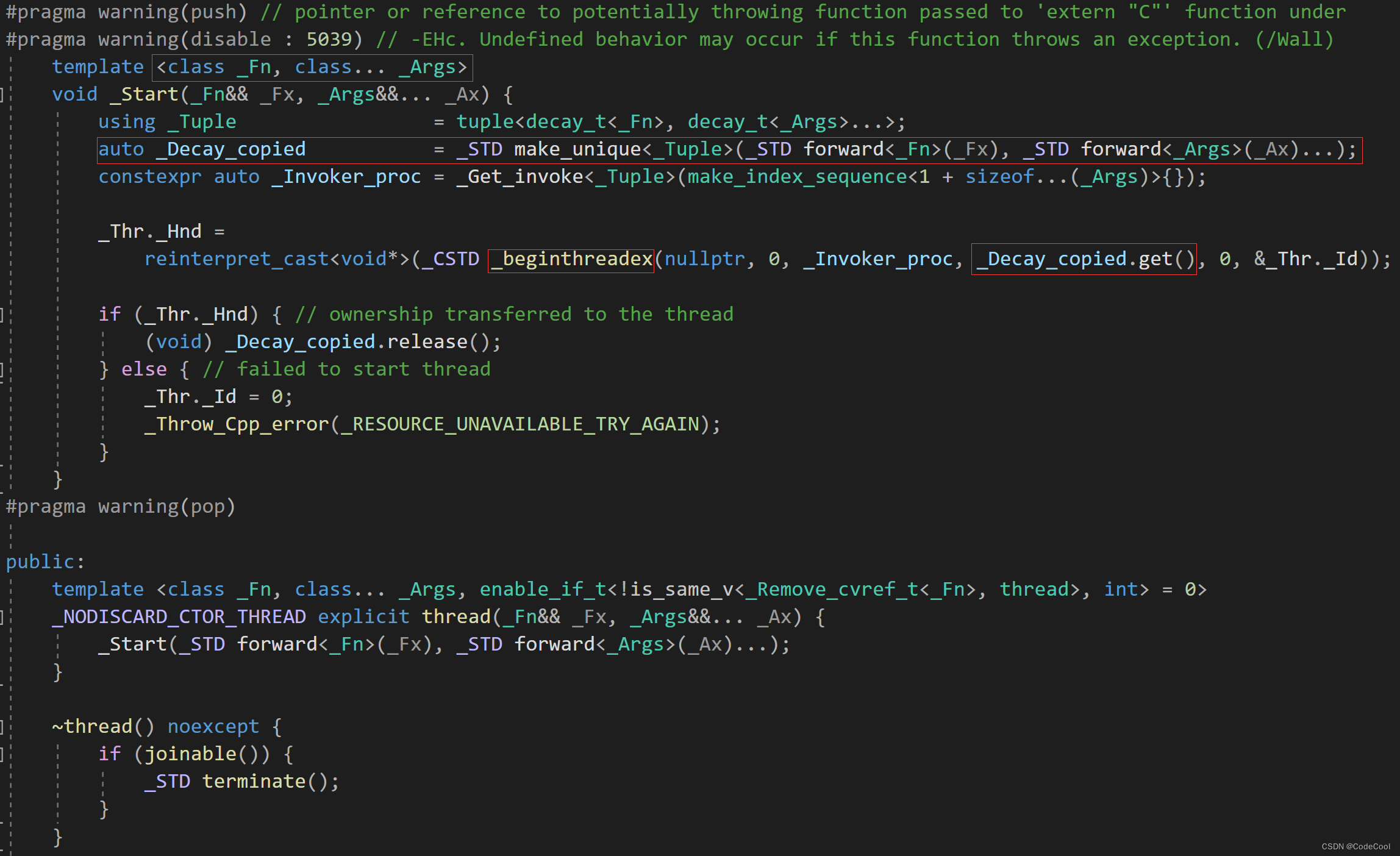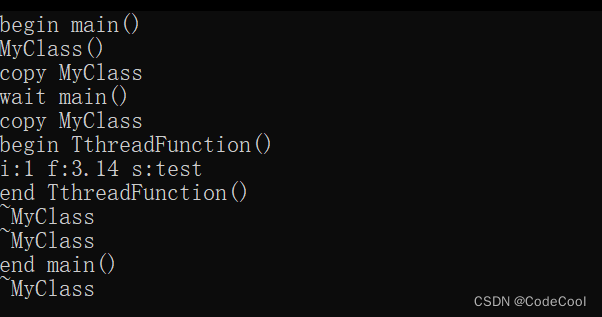C++11_14_17_20多线程
2023-12-20 07:09:05
@TOC
为什么使用多线程?
任务分解
耗时的操作。
任务分解。
实时响应。
数据分解
利用多核CPU处理数据。(base64编码,音视频或图像的处理。)
数据流分解
读写分离,解耦合设计。(微服务模块多线程通信。)
线程创建的方式
全局函数作为线程入口函数

线程参数传递对象的过程:
#include <thread>
#include <iostream>
using namespace std;
class MyClass
{
public:
MyClass() { cout << "MyClass()" << endl; }
MyClass(const MyClass& another) { cout << "copy MyClass" << endl; }
~MyClass() { cout << "~MyClass" << endl; }
private:
};
void TthreadFunction(int i,float f,string s, MyClass mc)
{
cout<< "begin TthreadFunction()" << endl;
cout << "i:" << i << " f:" << f << " s:" << s << endl;
cout << "end TthreadFunction()" << endl;
}
int main()
{
cout << "begin main()" <<endl;
MyClass mc;
thread t1(TthreadFunction,1,3.14,"test", mc);
cout << "wait main()" << endl;
t1.join();
cout << "end main()" << endl;
return 0;
}
运行结果:

通过传递指针或引用避免对象拷贝:
#include <thread>
#include <iostream>
using namespace std;
class MyClass
{
public:
MyClass() { cout << "MyClass()" << endl; }
MyClass(const MyClass& another) { cout << "copy MyClass" << endl; }
~MyClass() { cout << "~MyClass" << endl; }
string test;
private:
};
void TthreadFunctionPtr(MyClass * mc)
{
cout << "begin TthreadFunctionPtr()" << endl;
cout << "mc.test: " << mc->test << endl;
cout << "end TthreadFunctionPtr()" << endl;
}
int main()
{
cout << "begin main()" <<endl;
MyClass mc;
mc.test = "data";
thread t1(TthreadFunctionPtr, &mc);
cout << "wait main()" << endl;
t1.join();
cout << "end main()" << endl;
return 0;
}
运行结果:

#include <thread>
#include <iostream>
using namespace std;
class MyClass
{
public:
MyClass() { cout << "MyClass()" << endl; }
MyClass(const MyClass& another) { cout << "copy MyClass" << endl; }
~MyClass() { cout << "~MyClass" << endl; }
string test;
private:
};
void TthreadFunctionRef(MyClass& mc)
{
cout << "begin TthreadFunctionPtr()" << endl;
cout << "mc.test: " << mc.test << endl;
cout << "end TthreadFunctionPtr()" << endl;
}
int main()
{
cout << "begin main()" <<endl;
MyClass mc;
mc.test = "data";
thread t1(TthreadFunctionRef, ref(mc));
cout << "wait main()" << endl;
t1.join();
cout << "end main()" << endl;
return 0;
}
运行结果:

传递对象指针或引用生命周期 < 线程生命周期:
static。动态内存。指针对象作为类的数据成员,确保线程生命周期和对象生命周期相同。
成员函数作为线程入口
#include <thread>
#include <iostream>
using namespace std;
class MyClass
{
public:
MyClass() { cout << "MyClass()" << endl; }
MyClass(const MyClass& another) { cout << "copy MyClass" << endl; }
~MyClass() { cout << "~MyClass" << endl; }
void Display()
{
cout << "test: " << test << endl;
}
string test;
private:
};
int main()
{
cout << "begin main()" <<endl;
MyClass mc;
mc.test = "data";
thread t1(&MyClass::Display, &mc);
cout << "wait main()" << endl;
t1.join();
cout << "end main()" << endl;
return 0;
}
运行结果:

封装一个线程基类
业务需要创建线程时继承基类,线程的启动,停止等都在基类中完成。
只维护一个线程对象。
隐藏线程内部结构。
实现Main函数,线程就创建了。
#include <thread>
#include <iostream>
using namespace std;
class XThread
{
public:
virtual void Start()
{
is_exit_ = false;
th_ = std::thread(&XThread::Main, this);
}
virtual void Stop()
{
is_exit_ = true;
Wait();
}
virtual void Wait()
{
if (th_.joinable())
{
th_.join();
}
}
bool is_exit()
{
return is_exit_;
}
private:
bool is_exit_ = false;
std::thread th_;
virtual void Main() = 0; //线程启动的入口函数
};
class XThreadTest:public XThread
{
public:
void Main() override
{
while (!is_exit())
{
cout << "." << endl;
this_thread::sleep_for(1s);
}
}
string test;
};
int main()
{
XThreadTest test; //只维护这一个对象的生命周期
test.test = "test";
test.Start();
this_thread::sleep_for(5s);
test.Stop();
return 0;
}
运行结果:

文章来源:https://blog.csdn.net/qq_43648751/article/details/135095217
本文来自互联网用户投稿,该文观点仅代表作者本人,不代表本站立场。本站仅提供信息存储空间服务,不拥有所有权,不承担相关法律责任。 如若内容造成侵权/违法违规/事实不符,请联系我的编程经验分享网邮箱:veading@qq.com进行投诉反馈,一经查实,立即删除!
本文来自互联网用户投稿,该文观点仅代表作者本人,不代表本站立场。本站仅提供信息存储空间服务,不拥有所有权,不承担相关法律责任。 如若内容造成侵权/违法违规/事实不符,请联系我的编程经验分享网邮箱:veading@qq.com进行投诉反馈,一经查实,立即删除!